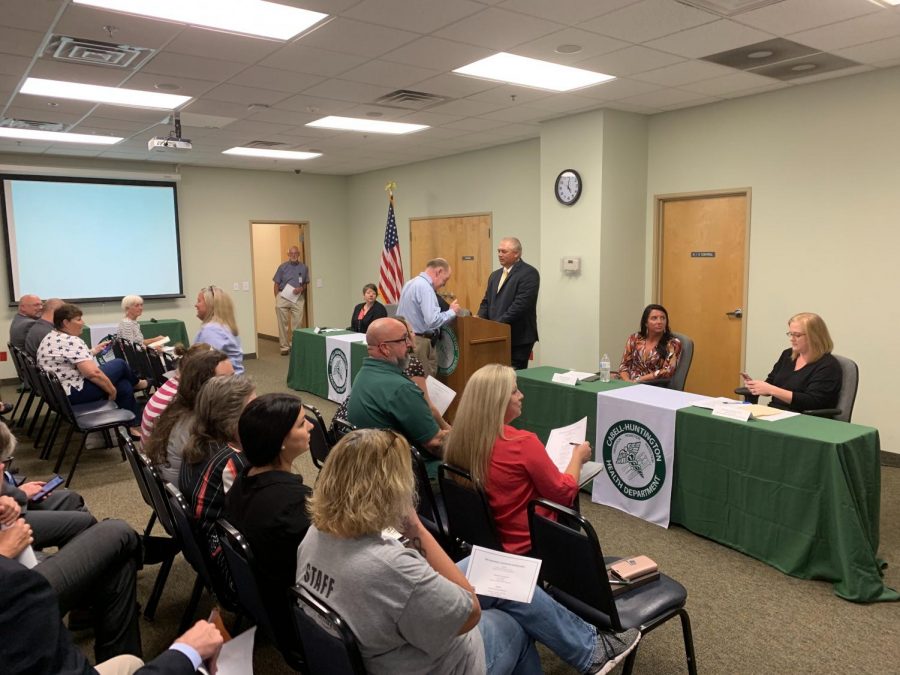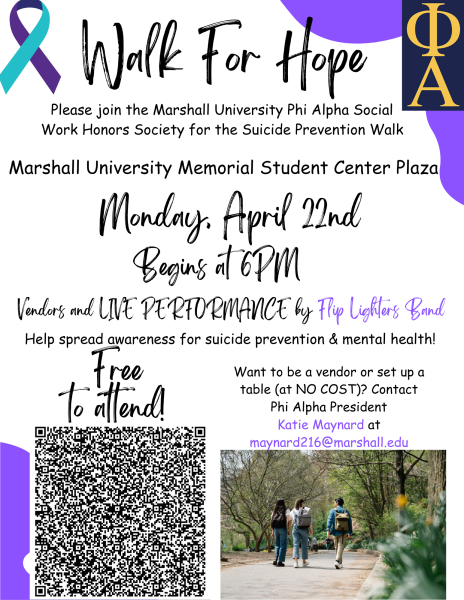Huntington community discusses HIV cluster, harm-reduction programs during public meeting
Panelists Dr. Kara Willenburg, Dr. Michael Kilkenny, Melissa Pemberton and Amanda Coleman prepare to discuss the HIV cluster in Cabell County with community members.
Citizens of Huntington listened to an overview on the HIV cluster in the city and the harm-reduction programs set in place to combat it during a public meeting Tuesday night, held by the Cabell-Huntington Health Department.
The Center for Disease Control and Prevention defines a HIV cluster as a group of persons diagnosed with HIV infection who have genetically similar HIV strains.
As of Sept. 3, 2019, Cabell County alone has had 76 confirmed cases of HIV, which is more than the entire state of West Virginia has had in a single year since 2008 (84 cases), according to West Virginia’s Department of Health and Human Resources.
The meeting featured Dr. Michael Kilkenny, physician director of the Cabell-Huntington Health Department, Dr. Kara Willenburg, chief of infectious diseases at the Marshall University Joan C. Edwards School of Medicine, Amanda Coleman, executive director for Cabell-Huntington Coalition for the Homeless and Melissa Pemberton, technology specialist at Prosource. The panelists provided information on the HIV cluster and participated in a question-and-answer session with community members.
During the discussion, numerous members of the community voiced their concerns about the syringe exchange, which is a part of the harm-reduction program. Some feel as if the syringe exchange has created more problems such as syringe litter. Others voiced how they would like to see the syringe exchange expanded, among those is Kilkenny.
“If there is a failure in the program, in my opinion, it is that we were always too small and that we were always operating on a model that was not best practice and did not provide enough sterile syringes for those who needed them,” Kilkenny said. “We didn’t have the money to do that, nor did we have the support to do that.”
Kilkenny also expressed the Health Department’s goal to stop the spread of HIV in two years, but to do so, he said he believes it will take more than just the current harm-reduction program.
“I am going to have to pull out all the stops. I think that we have a really good start on what it would take, but we may have to adapt it,” Kilkenny said. “Luckily, adapting is a lot faster than starting, and we have already started, so that’s why I think this goal is achievable.”
In June, Del. John Mandt Jr. (R-Cabell) and Cabell County Commissioner Kelli Sobonya called for an audit of Cabell-Huntington’s harm-reduction program, which was denied by the DHHR.
“We still would like to see an audit. It’s not to stop the program, it is to make the program better,” Mandt said. “Now, are we coming at it from a mean-spirited point of view? Absolutely not. I don’t want anybody to think that. We are just trying to gather information in our community, to be able to see what is going on here.”
Among the panelists at the event, there appeared to be some confusion on what information Mandt and Sobonya wish to gain though an audit of the harm-reduction program.
“I’m not exactly sure what it is they want to audit, I could give them a financial audit, which we have every year, I could provide that to them tomorrow. I’m just not exactly sure what it is they want to learn,” Kilkenny said.
According to Kilkenny, the Cabell-Huntington Health Department has received no communication from the DHHR or Governor Justice on the subject of an audit.
Currently, there are 795 individuals who are engaged in the syringe exchange program, compared to the estimated 1,200 individuals who were engaged when the program first began, according to the Cabell-Huntington Health Department.
Numerous healthcare officials who spoke at the event consider the harm-reduction program vital for the safety of all residents in the Huntington area. Coleman commented on how she thought people would be affected without the harm-reduction program in place.
“We would definitely have people using dirty needles, which means more people would have hepatitis, HIV and other diseases. A lot of people consider the program just to be a needle-exchange, but this also where a lot of people are accessing their healthcare, this is where people are accessing recovery coaches, as well as information about what to do during and after an overdose,” Coleman said. “All of that information would be lost if the program was abolished. So, I think we would see more overdoses, more disease and probably more hopelessness which leads to more addiction and homelessness.”
State and local officials plan to conduct more public meetings in the future to discuss the HIV cluster as well.
“This entire dialogue is positive, very proactive, and if we can get more people to show up to the next one, then we are better informed to answer the questions of those in the public who can’t get to these events,” Mandt said.
A second, unrelated forum on the HIV cluster will be at 6 p.m. Sept. 10 in the Christ Temple Church, organized by Mandt and Sobonya.
Blake Newhouse can be contacted at newhouse19@ marshall.edu.
Your donation will help continue the work of independent student journalism at Marshall University. If you benefit from The Parthenon's free content, please consider making a donation.





